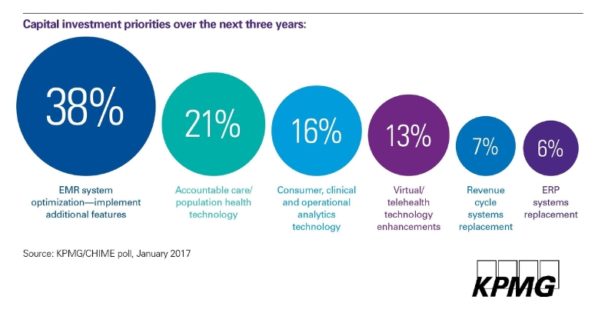EHR Optimization, Population Health Top Priorities for Health IT Spending
 Electronic Health Record (EHR) optimization and population health are high on the spending wish lists of Healthcare Information Technology executives, according to two new industry reports.
Electronic Health Record (EHR) optimization and population health are high on the spending wish lists of Healthcare Information Technology executives, according to two new industry reports.
Electronic Health Records have been implemented in over 95 percent of hospitals, according to the Office of the National Coordinator of Health IT. But analysis from KPMG finds healthcare organizations are still figuring out how to execute post-implementation strategies that effectively transform data analytics into valuable business outcomes and improve patient outcomes.
>>Implementing Epic? See our free hiring guide.
“[Most] EHRs – which represent thousands of resource hours and millions of dollars spent for many healthcare organizations – were implemented as one-time, factory boilerplate-style system installations,” writes Ralph Fargnoll, KPMG’s Advisory Managing Director. “With the need to realize the value of healthcare IT investments becoming apparent, healthcare leaders now acknowledge that information systems must be implemented as part of more strategic, long-term initiatives,” he states.
Over the next 3 years, 38 percent of CIOs plan to implement additional Electronic Medical Record (EMR) features and focus on system optimization, according to a survey conducted by KPMG and the College of Healthcare Management Executives (CHIME).

21 percent of CIOs anticipate making capital investments in accountable care and population health technology over the next 3 years. Other top upcoming capital investment plans include consumer/clinical and operational analytics (16 percent), virtual/telehealth technology enhancements (13 percent), revenue cycle systems/replacement (7 percent), and enterprise resource planning (ERP) systems/replacement (6 percent).
Healthcare CIOs are reportedly embracing the digital age of healthcare, albeit slowly. Thirty-nine percent of survey respondents claim they are “currently working” on a digital business strategy. But only 1 in 2 respondents claims to have a tangible digital business vision and strategy in the works.
A new survey from Philips and HIMSS Analytics of healthcare C-suite and IT directors, also confirms the growth of population health spending.
Three-quarters of respondents already have population health programs in acute care, and nearly two-thirds of respondents in both readmissions and patient education. Priorities for future implementations included: mobile wellness monitoring devices (58.3 percent), home monitoring devices (45.8 percent), and aging well or elderly care programs (42.5 percent).
Additional Survey Findings
- While care coordination remains a challenge overall in population health management efforts (19.2 percent), financial investment (20.8 percent) and patient engagement and adherence (20.0 percent) are considered the biggest population health challenges in 2017.
- Cloud-based technology is currently being used primarily for health information exchange (48.3 percent), followed by clinical data storage (34.2 percent). Health organizations plan to prioritize cloud-based technology on managed application deployment (40.8 percent) and big data analytics support (40.8 percent).
- Community diagnostic imaging centers (68 percent), ambulatory surgery centers (61 percent) and urgent care (60 percent) have seen the highest increases in the deployment of IT systems, compared to physician's offices in 2016.
